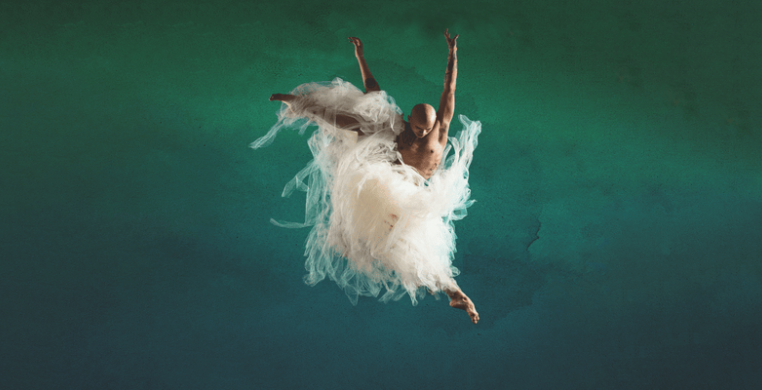Complexions Contemporary Ballet returns to Chicago for the first time in 18 years with “Stardust: From Bach to Bowie” at the Auditorium Theater on February 3.
The first half features five works of repertoire by Founding Co-artistic Director and Principal Choreographer, Dwight Rhoden, and Assistant Choreographer and Co-Founder, Desmond Richardson. The performance features recorded soundtracks from or inspired by the Baroque, Classical and Romantic eras of Western music, with lighting design by Michael Korsch and Costume design by Christine Darch and DRSquared.
“Hissy Fit” (2006) is a perfect example of the Rhoden/Complexions style, breaking the ostensible rules of ballet at the right times. The full company, in nude-color leotards and shorts, appears as humans without ostentation. Limbs go rigid when you least expect them and become rubbery without warning. A duet at the outset resembles Adam and Eve, blank slates discovering the world anew. Korsch’s use of bright spotlights in the background both dazzle the audience and give the dancers a black, inky outline.
“Choke” (2006) features dancers Christian Burse and Marissa Mattingly in a pas de deux with folk dance elements set to the “Summer” movement of Vivaldi’s “Four Seasons.” Dressed in green, Burse and Mattingly wind and intertwine their arms in the air like vines growing in fast motion. They elongate accents at the end of musical phrases at the end of musical phrases by grabbing their feet and tracing arcs overhead. They are playful and lithe in a spiritually uplifting work.
A second pas de deux, “Endgame/Love One” (2022), is more traditional. Dancing to Bach’s “Kyriena,” Chloe Duryea moves like a person possessed. Miguel Solano is the strong force trying to rein her in. During a series of furious spins, Solano pauses Duryea several times, freezing her momentarily in oblong-shaped poses. Several times Solano drags Duryea across the floor on her toes, like skating across ice, eliciting audible gasps and hoots from the audience.
 Photo by Sharen Bradford
Photo by Sharen Bradford
In “Elegy” (2020), Dancer Jillian Davis performs solo to the adagio sostenuto of Beethoven’s “Moonlight Sonata.” The somber “one-two-three” ostinato and powerful downbeat accents pull Davis in opposing emotional and physical directions. Pique turns alternate from delicate, with toes pointed at the knee, to violent, with the leg extended and thrown like a bludgeon. As the ostinato creeps towards a crescendo, so too does Davis creep close to the floor with finger pointing forward and hand covering mouth as if telling a secret. Dedicated to Rhoden and Richardson’s own mothers, “Elegy” encapsulates the experience of creating life only to have to let it go.
“Snatched Back From The Edges” (2021) brings the full company back to the stage to conclude the first half of the program. The dancers’ feet punctuate Tye Tribbett’s music with the tsch-tsch-tsch in the rhythm. Dancers rise to their toes with arms outstretched, perfectly coinciding with the heavy drop of the beat. Rhoden’s contemporary balletic choreography merges surprisingly well with the trap beaT. Other progressive ballet companies should take note.
The second half of the show features the titular “Stardust” (2016), a work in nine parts set to a career-spanning compilation of some of David Bowie’s most famous hits. The format is the same for each piece, with different soloists embodying some of the late pop icon’s personas, lip synching the lyrics while prancing across the stage with dancers behind them providing texture.
As Bowie sings “Ch-ch-ch-ch-chan-ges,” dancers dressed in blue and plum leotards cheekily slap their thighs and walk on pointe like runway models. The ominous drum beat from “Space Oddity” shows dancers ready for liftoff, walking confidently and defiantly spreading their arms with chests puffed out—“Can you hear me Major Tom?” During “Modern Love,” the stage explodes into a full-on party, with dancers bouncing while doing the “pony,” moving knees back and forth in a “twist” and engaging in amicable dance combat (ballet-fu?). All the while the rotating cast of soloists, faces painted with a sparkling lightning bolt à la Ziggy Stardust, weaves in an out of the ensemble, peppering in short dance breaks while mouthing the verse.
“Stardust” is high on energy but low in the diversity of themes it presents. The music video/pop music concert aesthetic of singer in front of backup dancers wears thin despite the enthusiastic performances by the soloists. The constant lip synching comes off as gauche. Many of the dance moves—toe sliding, thigh slapping, grabbing a foot and tracing a line overhead, arms spread wide and chest out—are presented in the first half of the show, giving some sections of Stardust a copy/paste feel.
“Stardust” succeeds in recreating the rock concert experience. Despite my grumblings, the lip synching is done well. The dancing by the ensemble is fast, frenetic and full of abounding joy. What it lacks in depth, it makes up for in sheer entertainment.
“Stardust: From Bach to Bowie” is an overall balanced show, half contemplative and half fearlessly fun. Complexions Contemporary Ballet provided Chicago audiences with a unique experience—let’s hope they return soon!

